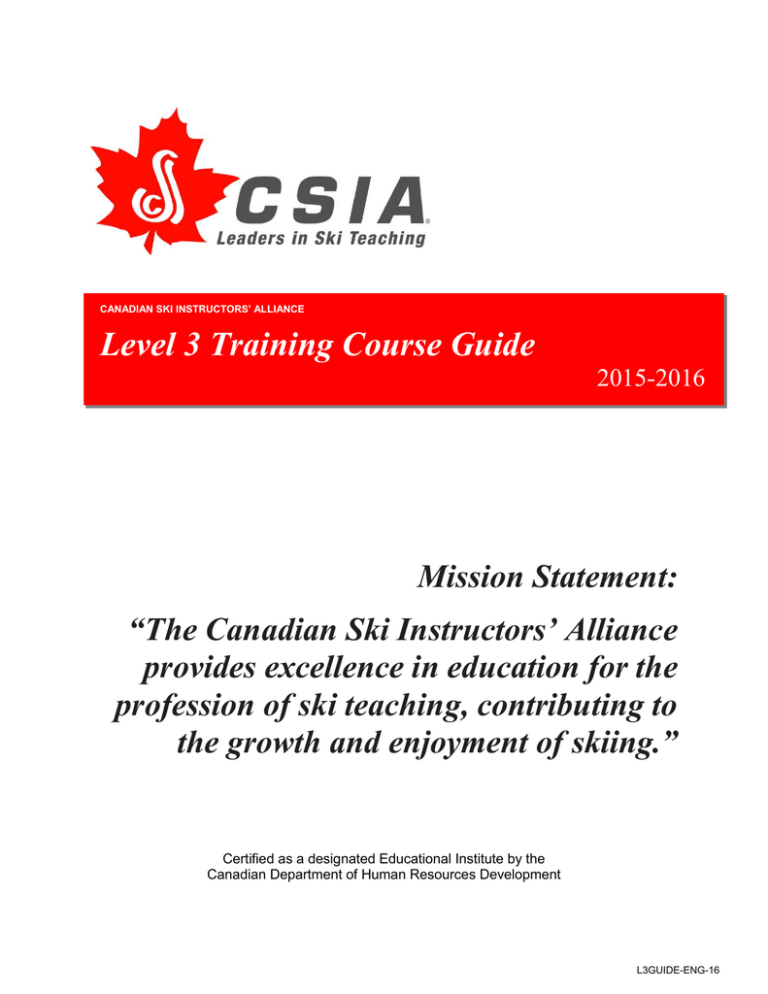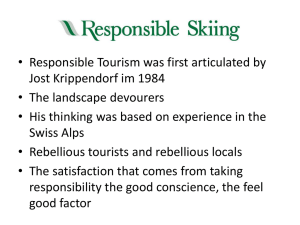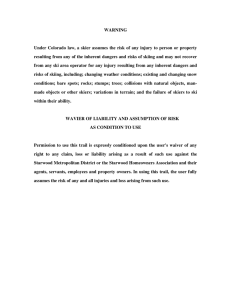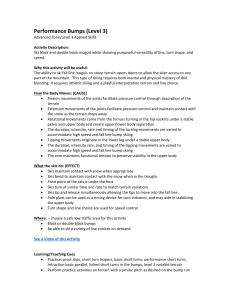
CANADIAN SKI INSTRUCTORS’ ALLIANCE
Level 3 Training Course Guide
2015-2016
Mission Statement:
“The Canadian Ski Instructors’ Alliance
provides excellence in education for the
profession of ski teaching, contributing to
the growth and enjoyment of skiing.”
Certified as a designated Educational Institute by the
Canadian Department of Human Resources Development
L3GUIDE-ENG-16
Table of Contents
L3 introduction/overview
3
L3 Training schedule
4
Assessment & Development Workshop
5
L3 Standard and Testing
8
Daily Journal
14
Level 3 Development Plan Forms
15
Canadian Ski Instructors’ Alliance
©Copyright 2015, all rights reserved
Printed in Canada
401-8615, St-Laurent blvd.
Montréal, QC H2P 2M9
Canada
www.snowpro.com
2
Level 3 Training course guide
Level 3 Introduction
The Level 3 ski instructor certification is for advanced skiers that have passed the Level 2
certification. The program develops ski instructors to an advanced level in practical ski teaching
methods, technical understanding and development, and guest service skills. The successful
candidate is certified to teach skiers up to an advanced parallel skill level.
Level 3 Certification Structure
Both the Level 3 Training module and the Education credits requirements must be fulfilled
before attending the L3 exam.
Level 2 instructors certified prior to the 2013/14 season have been awarded an equivalency
of 10 credits.
Exam candidates, including first-time participants, have the option to attend only the ski or
teach exam.
Members needing a retest on either component (ski or teach) can re-attend the exam at any
time, without ever having to re-attend the Training course.
The process of certification is not limited in time.
3
Level 3 Training course guide
Level 3 Training Schedule
The Level 3 training module provides training in advanced skiing and teaching skills, with
development strategies and recommendations for Level 3 exams.
DAY 1
Registration
On snow (4.5 hours)
Ski improvement at advanced performance level
o Establishing technical reference points for advanced skiing
o Exposure to varied terrain
o Individual development objectives
o Understanding IACRCv principles
Indoor (1.5 hours)
Group debrief with video from the day
A&D workshop
o Review of technical reference points
o Set objectives for Day 2 teaching
DAY 2
On snow (4.5 hours)
Development of advanced teaching skills
o Practice teaching with course conductor facilitation, based on technical priorities
of day 1
Observation of learners and environment
Creating priorities and appropriate follow up
Managing individual objectives
Use of terrain and creating outcomes with tactics
Indoor (1 hour)
Group debrief
L3 Standards and exams workshop
DAY 3
On snow (4 hours)
Ski-off and individual strategies review
o Review individual development strategies with skill / drill practice
o Review ski-off runs and terrain
Indoor (2 hours)
One-on-one assessments with Feedback Forms and exam recommendations (approx.
15 min per candidate)
4
Level 3 Training course guide
ASSESSMENT AND DEVELOPMENT (60 min)
Assessment: Assessing skiers starts with knowing your student. We use the Technical
Reference as a tool to determine the desired overall improvement. Skiing skills are the tools we
use to develop specific movements.
Development: Approaches to developing skiers is based on your initial assessment.
Approaches will vary based on level of confidence, age and overall ability.
Skier #1
1) Relative to turn size, speed and performance, is this skier leading the turning effort with the
lower body?
2) Are they engaging/using the side cut of the ski?
3) Do they combine the two?
4) Describe the skill development strategy:
5
Level 3 Training course guide
Skier #2
1) Relative to turn size, speed and performance, does this skier manage separation?
2) Is edging controlled by angulation?
3) Describe the skill development strategy:
Skier #3
1) Relative to turn size, speed and performance, does the skier use all joints to stay in balance?
2) Are they able to manage forces acting on the ski and skier?
3) Describe the skill development strategy:
6
Level 3 Training course guide
Skier #4
1) Relative to turn size, speed and performance, is this skier able to control pressure to carry
momentum from turn to turn?
2) Describe the skill development strategy.
Level 3 Standard and Testing
Level 3 Exam Review
After completing the Level 3 Training course and having accumulated a total of 40
Education Credits or more, the participants an attend a scheduled 2-day exam with no
time limitation. The exams are scheduled over two consecutive days; the teaching exam
being held on day one and the ski off being held on day two. Candidates have the option
of challenging only one of the two exams but must pass both skiing and teaching aspects
to receive the full Level 3 certification.
Re-test on skiing or teaching
Candidates who fail skiing or teaching can be re-tested on that portion with no time
limitation. Candidates passing one portion will never have to be re-tested for that portion.
EXAMS SCHEDULE
DAY 1
AM
- Warm-up and terrain review
- Teaching exam
PM
- Teaching Exam
DAY 2
AM
- Warm-up and terrain review
- Ski Off
PM
- Ski Off
- Results presentation
This schedule may be adjusted in consideration of conditions, weather and facilities.
8
Level 3 Training course guide
SKIING ASSESSMENT:
Skiing is evaluated in a ski-off. The ski-off is reviewed during the course and each candidate will
be given clear directions for exam preparation. Adequate time must be devoted to skiing
preparation and it is recommended to seek coaching from a current Level 4 during the winter
training period.
Brief review of the Ski-off runs during the warm-up.
Ski-off runs: Intermediate Parallel Turns, Advanced Parallel Turns, Advanced Short
Radius Turns and a Bump Run.
Candidates will have 2 runs, with the best run to be counted.
Course conductors determine the terrain and length for each run.
Run criteria will be explained by the course conductors.
Marking system:
Each run is marked on 10 points and the passing mark is 6 out of 10
Passing criteria.
o
Obtain an overall of 60 % average
o
Must pass 3 runs out of 4.
o
Must pass the bump run.
o
Must pass the Intermediate parallel run.
Each ski off run has an objective that relates to speed, turn shape and level of ski
performance. Within all ski off runs, the CSIA technique is to be used to achieve these
objectives. Both the objective and technique are considered in determining individual
marks. The scale works as follows (read the mark of 6 first)
8 or higher – precise execution of run objective AND precise technical execution. Example: can
effectively control line in the bumps and maintain fast/advanced speeds AND is precise technically, well above the
Level 3 standard.
7 –precise execution of run objective OR precise technical execution. Example: skier is able to
control turn shape but at a higher speed and level of performance OR timing and coordination is more precise
resulting in a more dynamic run.
6 –achieves the objective of the run and uses appropriate technique.
5 –achieves the objective of the run, but does not use appropriate technique OR uses
appropriate technique but does not achieve the objective of the run. Example: correct speed and turn
shape, however, shows rotation OR good technique, but speed is too slow or too fast for the objective of the run.
4 –fails to achieve the objective of the run and does not demonstrate appropriate technique.
Example: rotation affects the ability to maintain speed control and turn shape.
3 or lower – does not achieve the run objective and technique is well below the L3 standard.
Example: basic skiing skills are deficient such as stance and balance, therefore, speed, turn shape and ski
performance are greatly affected.
9
Level 3 Training course guide
TEACHING ASSESSMENT:
The teaching exam is 60 minutes in duration, including lift time.
Candidates must teach to a minimum of 4 students and a maximum of 6.
The choice of terrain is at the discretion of the candidates. However, if time or terrain
availability is a problem, the course conductor may help direct terrain choice.
Each candidate will teach an advanced lesson, based one of these themes :
o
Advanced Ski Improvement
o
Bumps
Teaching assignments are given the morning of the exams.
Teaching order is determined by assignments and terrain at the discretion of the course
conductor.
Marking System:
NI = Needs Improvement, ME = Meets Expectations
To Meet Expectations relative to the Level 3 teaching standard, the Performance Criteria are
evaluated as follows:
The candidate:
Is aware of the principles of Experiential Education;
Recognizes the four Decision Making Tools;
Uses demonstrations to complement teaching.
Individual Performance Criteria:
Are apparent, however, may not necessarily follow a logical progression;
Are utilized, but lack consistency;
Are incorporated consciously.
TEACHING ASSESSMENT
Element Of Competency
Performance Criteria
Experiential Education Cycle
In an advanced lesson,
understand the CSIA
Decision Making Process
within the Experiential
Education cycle.
Experience:
Design concrete tasks and/or activities for learning
Reflection:
Engage the student to reflect on the experience.
Conceptualization:
Involve learner through effective questioning;
Experimentation:
Develop one variable at a time relative to skiing objective.
10
Level 3 Training course guide
TEACHING ASSESSMENT (continued)
Performance Criteria
Element Of Competency
In an advanced lesson,
understand the CSIA
Decision Making Process
within the Experiential
Education cycle.
Decision Making Process
Learning Contract:
Assess the students’ needs (physical and psychological);
Accommodate different learner types;
Set achievable goals and tasks;
Use two way communications;
Provide individual feedback;
Use debriefing.
Situation:
Demonstrate safe teaching practices;
Choose appropriate terrain;
Use terrain to assist development;
Pace lesson appropriately.
Skiing Objective:
Based on student;
Based on situation;
Related to Technical Reference;
Relative to speed, size of turn and level of ski performance.
Motor Skill Development:
Choose a skill to develop;
Relate skill development to skiing objective;
Relate skill development to Technical Reference;
Provide an understanding of cause and effect;
Choose appropriate complexity or simplicity of task;
Spend appropriate time on task.
Demonstrations
Adapted to skill level of student;
Adapted to terrain;
Technically appropriate.
11
Level 3 Training course guide
TECHNICAL ASSESSMENT
Element Of
Competency
Demonstrate
effectively from
intermediate to
advanced level
Performance Criteria
General performance criteria for Advanced parallel on groomed black
terrain:
Objective:
Maintain advanced speeds;
Blend skills to achieve a steered arc;
Maintain consistent turn shape relative to speed and terrain.
Technique:
Turning is led by the lower body and the ski design.
Managing upper and lower body separation allows for angulation to
provide grip.
Use of all joints helps maintain a centred stance and provides the ability to
manage forces acting on the ski and skier.
Coordinated movement patterns direct the forces acting on the skis and
the momentum of the skier from turn to turn.
Ski Off Run Objectives: (maintaining technical performance criteria above)
Intermediate Parallel Turns:
Symmetrical/rhythmical parallel turns on intermediate terrain (blue/black);
Maintains Intermediate speeds;
Consistent medium sized turns relative to speed and terrain;
Steering adjusted to terrain and speed.
Advanced Short Radius:
Controlled round short turns on advanced (black) terrain;
Maintain consistent speed;
Maintain rhythm and symmetry for the entire run;
Maintain a consistent and rhythmical pole plant.
Bumps:
Demonstrate control in advanced varied terrain (moderate black terrain);
Adjust technique to terrain and snow conditions;
Show the ability to choose a line in varied terrain;
Maintain snow contact the majority of the run.
Advanced Parallel:
Linked and efficient parallel turns executed at advanced speed on
groomed advanced (blue / black) terrain:
Manage medium to long radius turn shape relative to speed and terrain;
Utilize ski design to assist in a steered arc.
12
Level 3 Training course guide
DAILY
JOURNAL
DAY 1
DAY 2
DAY 3
13
Level 3 Training course guide
CSIA LEVEL 3 SKI DEVELOPMENT PLAN FORM
Name:
Location:
Candidate #:
Date:
Technical Proficiency
Objective
Technique
• Maintains advanced speeds
• Leads the turning effort with the lower body and ski design
• Manages separation for angulation to provide grip
• Blends skills to achieve a steered arc
• Maintains consistent turn shape relative to • Use of all joints helps maintain a centred stance and provides the
speed and terrain
ability to manage forces acting on the ski and skier
• Coordinated movement patterns direct the forces acting on the skis
and the momentum of the skier from turn to turn
Specific Skill Development Strategies
__________________________________________________________________________________
__________________________________________________________________________________
__________________________________________________________________________________
__________________________________________________________________________________
__________________________________________________________________________________
__________________________________________________________________________________
__________________________________________________________________________________
__________________________________________________________________________________
__________________________________________________________________________________
Demonstrations
Advanced skiing
Intermediate Parallel
__________________________________________________________________________________
__________________________________________________________________________________
__________________________________________________________________________________
__________________________________________________________________________________
__________________________________________________________________________________
Advanced Parallel
__________________________________________________________________________________
__________________________________________________________________________________
__________________________________________________________________________________
__________________________________________________________________________________
Short__________________________________________________________________________________
Radius
__________________________________________________________________________________
__________________________________________________________________________________
__________________________________________________________________________________
__________________________________________________________________________________
__________________________________________________________________________________
Bumps
__________________________________________________________________________________
__________________________________________________________________________________
__________________________________________________________________________________
__________________________________________________________________________________
__________________________________________________________________________________
Course Conductor:
L3DP -ENG-16
14
Level 3 Training course guide
CSIA LEVEL 3 TEACHING
DEVELOPMENT PLAN
Name:
Location:
Member #:
Date:
Experiential Education Cycle
Development Strategies
relative to the Level 3 teaching criteria
Experience
Design concrete tasks and/or activities for learning
Reflection
Engages the student to reflect on the experience
Conceptualization
Involves the learner through effective questionning
Experimentation
Develops one variable at a time relative to skiing objectives
__________________________________________________________________________________
__________________________________________________________________________________
__________________________________________________________________________________
__________________________________________________________________________________
__________________________________________________________________________________
__________________________________________________________________________________
__________________________________________________________________________________
__________________________________________________________________________________
__________________________________________________________________________________
__________________________________________________________________________________
__________________________________________________________________________________
__________________________________________________________________________________
Decision Making
Development Strategies
relative to the Level 3 teaching criteria
__________________________________________________________________________________
Learning contract
__________________________________________________________________________________
Assesses the student needs (physical and psychological)
__________________________________________________________________________________
Accommodates different learner types
__________________________________________________________________________________
Sets achieveable goals and tasks
__________________________________________________________________________________
Provides individual feedback
__________________________________________________________________________________
Uses two way communication
__________________________________________________________________________________
Uses debriefing
__________________________________________________________________________________
Situation
__________________________________________________________________________________
Demonstrates safe teaching practices
__________________________________________________________________________________
Chooses appropriate terrain
__________________________________________________________________________________
Uses terrain to assist development
__________________________________________________________________________________
Paces lesson appropriately
__________________________________________________________________________________
Skiing objective
__________________________________________________________________________________
Chooses objective based on the student
Chooses objective based on the situation
__________________________________________________________________________________
Relates objective to Technical Reference
__________________________________________________________________________________
Relates objective to speed, size of turn and level of ski performance__________________________________________________________________________________
Motor skill development
__________________________________________________________________________________
Chooses a skill to develop
__________________________________________________________________________________
Relates skill development to skiing objective
__________________________________________________________________________________
Relates skill development to Technical Reference
__________________________________________________________________________________
Provides an understanding of cause and effect
__________________________________________________________________________________
Chooses appropriate complexity or simplicity of task
__________________________________________________________________________________
Spends appropriate time on task
__________________________________________________________________________________
Demonstrations
Adapts to skill level of student
Adapts to terrain
Uses appropriate technique
Course Conductor:
L3DP-ENG-16
15
Level 3 Training course guide





